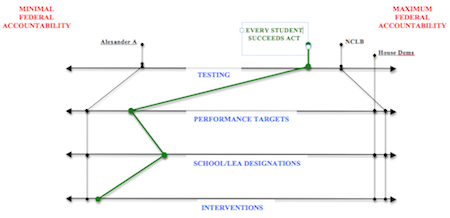Earlier this year, when it looked like ESEA finally had a chance of being reauthorized, I came up with a graphic for assessing the accountability provisions of the various proposals. I argued that, at least when it comes to federal policy, we should think about accountability as having four dimensions: tests, performance targets, school designations, and interventions.
My goal was to show that each dimension had a spectrum of possibilities, ranging from heavy-handed federal prescription to virtually no role for Uncle Sam. An upshot of this is that proposals could vary in countless ways—for example, one could be to beef up the federal government’s role in testing and targets, while another only had Uncle Sam active in designations, while another only had federal mandates on school interventions.
In this post, however, I showed that the eleven major proposals naturally sorted into three categories: some were prescriptive across the board, some were hands-off apart from testing, and some pushed hard on targets while backing off on designations and interventions. The big question was whether there was a single combination of approaches on the four dimensions that could garner sufficient support in both Houses of Congress and at the other end of Pennsylvania Avenue.
Well, the compromise bill is now out. Ed Week has done a great job with its cheat sheet, overview, and this summary of reactions. Politico is tracking it closely. Washington Post’s Emma Brown wrote it up here. Mike has his famous eliminated-survived table. Rick Hess scored it.
At the risk of analysis overkill, I’ve assessed the Every Student Succeeds Act using my four-dimension accountability graphic. Rather than cluttering it up with the eleven other proposals, here’s the tool with just the proposals that represented the far ends of the spectrum. NCLB and the 2015 House Democrat bill were the most federally prescriptive; what became known as “Alexander A” was the least prescriptive.
The biggest takeaways are first, the compromise is less prescriptive than NCLB across all four dimensions and much less prescriptive on three of four; and second, the bill doesn’t completely eviscerate the federal role in accountability, particularly related to designations for struggling schools.

Here’s a quick run-down of the four dimensions.
Testing
NCLB’s testing requirements remain. However, several new elements make the testing regime less intrusive. For instance, scores from reading and math tests will comprise a smaller portion of each state’s accountability system. States must include at least one additional student-performance measure as well as at least one measure related to school success, like grit, student engagement, or school climate. Importantly, states will have significant discretion over how to weight the various metrics. Moreover, a number of states will be able to pilot new approaches to testing and accountability through a “demonstration” initiative.
Performance Targets
In a major departure from current policy, the federal government is getting out of the business of directing states’ K-12 goals. The new legislation ends both NCLB’s 100 percent-proficiency target and the waivers’ performance-target framework. The legislation requires states to set long-term and interim goals (in areas such as proficiency and graduates rates) and to set targets for closing achievement gaps. So the federal government isn’t halting its pursuit of improved student achievement, but it is saying that it’s up to states to lead the chase.
Designations
NCLB ended up categorizing tens of thousands of schools (e.g. SINI, corrective action, restructuring). Waivers decreased the number of schools receiving designations by limiting the number of categories and directing how those categories were defined (e.g. Priority, Focus, Reward), but the feds were still telling states how to classify many of their schools.
On designations, the new law is considerably less prescriptive than both NCLB and waivers, but it is more directive than it might’ve been. State reports cards must have a system for “meaningfully differentiating all public schools in the State.” But rather than leaving it at that (that is, giving states total discretion over categories), the legislation requires states to categorize and ensure interventions for the lowest-performing five percent of schools, high schools where fewer than two in three students graduate, and schools where subgroups of students persistently lag behind. States have a good bit of authority over how to define these categories, but the categories certainly have the same shape as Priority and Focus schools under waivers.
Interventions
The biggest change from NCLB and waivers relates to interventions for schools identified for improvement. Since 2002, the federal government has had a good bit of say over what will be done with persistently underperforming schools. No longer. In fact, the new law pushes these decisions not just to states but all the way down to districts and schools (an issue to which I’ll return in a follow-up post). For the bottom five percent of schools, LEAs must simply develop and implement “evidence-based” plans. Schools with persistently lagging subgroups are charged with developing their own interventions.
There’s so much to be said about the approach taken by the Every Student Succeeds Act. For now, I’ll leave it at this. If your primary interest is in getting Uncle Sam to back off of America’s schools, you can start to prepare the Mission Accomplished banner. If your primary interest is in great K-12 accountability systems, you can’t direct your attention to state superintendents and state boards of education fast enough.
—Andy Smarick
This post originally appeared on the Fordham Institute’s Flypaper.


